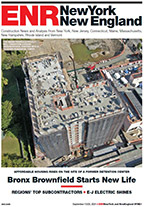September Construction Starts Climb 13% Nationwide
New construction starts in September advanced 13% to a seasonally adjusted annual rate of $556 billion, according to McGraw Hill Construction, a division of McGraw Hill Financial. Nonresidential building bounced back after losing momentum in August, and the nonbuilding construction sector was lifted by the start of several large power plants, which ran counter to the sharply downward trend for electric utilities that’s been present during 2013.
For the first nine months of 2013, total construction starts on an unadjusted basis were reported at $379.3 billion, up 2% from the same period a year ago. If electric utilities were excluded from the year-to-date statistics, total construction starts in the first nine months of 2013 would be up 11%.
The September data raised the Dodge Index to 118 (2000=100), up from 104 in August and the highest reading for the Index so far in 2013. From January through August this year, the index had hovered within the fairly narrow range of 98 to 107.
“The overall level of construction activity will be affected by the presence of large projects in any one given month, and that was certainly the case in September,” said Robert A. Murray, vice president of economic affairs for McGraw Hill Construction. “While the extent of September’s gain overstates the current health of construction, the latest month did provide positive news for nonresidential building which continued the up-and-down pattern that’s occurred during 2013. The September gain for nonresidential building reflected the manufacturing plant category posting a strong increase, commercial building staying close to its recently improved pace, and several institutional structure types rising from previously weak levels.
“After the downward trend that’s been under way from 2009 through the first half of 2013, the institutional building sector may now be starting to stabilize, which is necessary for total nonresidential building to register growth. At the same time, the recent Congressional impasse over federal appropriations for fiscal 2014 and raising the debt ceiling only adds to the sense of uncertainty, which hampers renewed expansion for nonresidential building going forward,” Murray said.
Nonresidential Building
Nonresidential building in September jumped 24% to $182.8 billion (annual rate). The manufacturing plant category soared 289%, boosted by an $800-million ammonia-production facility and a $615-million steel mill, both in Louisiana. Commercial building in September receded 3% following its 4% gain in August, due to a mixed pattern by project type.
Hotel construction in September increased 9%, supported by the start of a $75-million hotel resort in Anaheim, Calif., while office construction edged up 1%. Large office projects that reached groundbreaking in September included a $435-million campus for Facebook in Menlo Park, Calif., a $139-million county government office building in Van Nuys, Calif., and the $129-million renovation of a financial services office building in Des Moines.
Store construction in September held steady with its August amount, helped by $75 million for the retail portion of the $460-million Millennium Tower mixed-use building in Boston. The commercial building total in September was pulled down by a 34% drop for warehouse construction.
Institutional building in September advanced 24%, rebounding after a 17% decline in August. The health care facilities category, which has been lackluster for much of 2013, jumped 144%. There were four large hospital projects that reached groundbreaking in September—a $437-million replacement hospital at Fort Bliss in El Paso, Texas; a $323-million cancer treatment center in Omaha; a $250-million hospital tower in Oak Lawn, Ill.; and a $200-million medical center in Birmingham, Ala.
The educational building category in September grew 13%, aided by these projects: a $93-million, two-building complex at Montclair State University in Montclair, N.J.; an $82-million public library in Austin, Texas; and a $74-million teaching and learning center at UCLA in Los Angeles. For the smaller institutional categories, both public buildings and churches showed improvement in August, climbing 36% and 18% respectively. Decreased activity in September was reported for amusement-related projects, down 27%, and transportation terminals, down 46%.
Nonbuilding Construction

